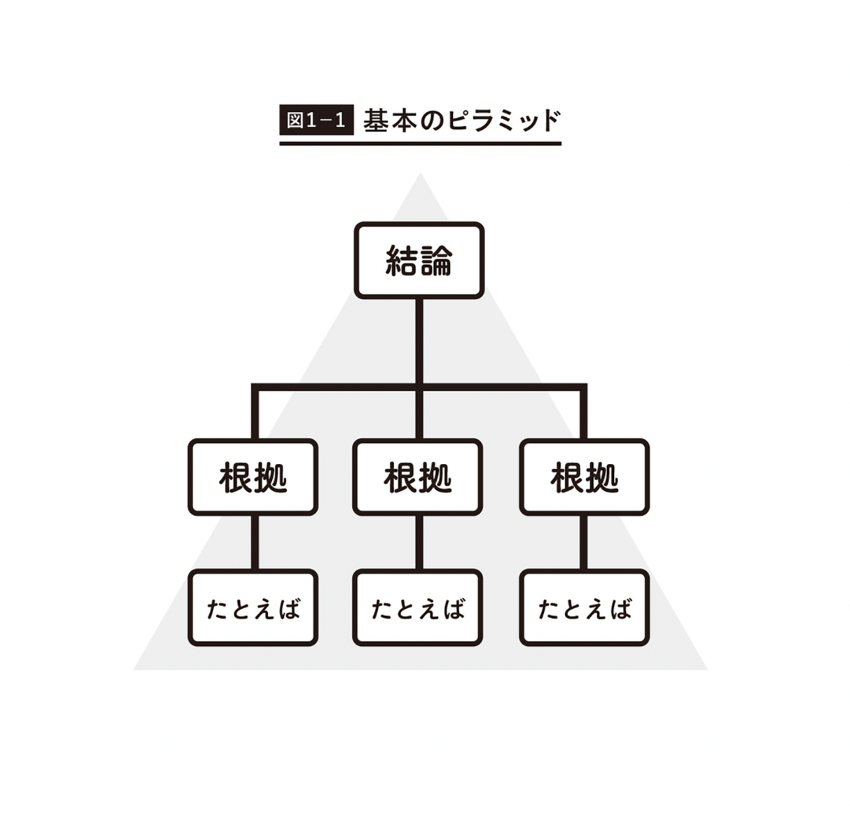ステークホルダーとのコミュニケーション方法

はじめに
こんにちは、KINTOテクノロジーズのグローバル開発グループでPdMをしている高羽です。
今回はPdMとして様々なステークホルダーと話をしながら進めていくために効果的なコミュニケーションの取り方、またそのメソッドについて書いていきます。
これまでプロダクトに関わる仕事を長年やってきて、人とのコミュニケーションがプロジェクトの雰囲気やプロジェクトの成功にダイレクトに繋がると感じてきました。
その中で私がこれまで経験した、また今でも実践し日々トレーニングしている事を紹介します。
ピラミッド型の話し方
PdMの仕事をする中で人に何かを伝えるという事が多々あります。その中で私は相手に分かりやすく、相手がより理解できるために、あるメソッドを意識してコミュニケーションを図っています。
そのメソッドとはピラミッド型のロジカルな話し方です。
そのメソッドを使うかの根拠としては3つあります。
1つ目は、自分がそもそも口下手で人前で話すのがあまり得意でないので、何かしらのメソッドが必要だと感じている事です。
例えば、プレゼンやディスカッションしているとき、本当に伝わっているか心配になり、さらに上手く伝えられなくなってしまうというループに陥らないためにそのメソッドを使います。
2つ目に、PdMという仕事はいろんな人々と話す事が多々あり、必然的にいろんな意見が出てきて調整するのに大変ですが、そのメソッドを使うことで割とスムーズに進めることができます。
例えばPdMはプロダクトに関わる多くのステークホルダーと話をして、プロダクトをまとめ上げる役割ですが、ステークホルダー同士の意見が違ったり、どの意見を選択すればいいのかわからなくなりがちです。そのときにこのメソッドを使えば割とスムーズに解決することができます。
3つ目として、物事を相手に正確に伝える為には、ロジカルに話す事が必要です。
ロジカルに話すことで聞く相手の理解を高める事ができます。例えば他人に何かを説明する際に、一般的には、ロジカルに話す方が話を聞く側が理解しやすいという傾向があります。ロジカルな内容、伝え方をすることで相手に対して理解しやすい親切な伝え方を実現できるという事があります。親切な伝え方はプロジェクトの雰囲気や成功にも関係してくるので、物事の伝え方は非常に大切です。
さて、今話した内容はピラミッド型のロジカルな話し方を意識して話しました。
このメソッドは以前私が勤めていたインターネットの会社でセミナー等で直接指導して頂いた伊藤羊一さんが執筆された本「1分で話せ」[1]に記載されています。
その一部を使って私が最初にPdMとして必要なものとしてピラミッド型のロジカルな話し方について説明しました。
では、ここでピラミッド型の伝え方について説明します。

このピラミッドの1番上にあるとおり、まず最初に「結論」を伝えます。「一番伝えたいことを最初に言う」 ということです。
次の段がその「根拠」となります。なぜその結論となるのかの理由を述べます。根拠の数は1つだけでは弱いので、3つ位が良いとされています。
そして3段目は、「たとえば」と事例を説明していきます。人は具体的な事例があればあるほど聞き手は納得する傾向にあるので、この部分は納得の肉付け(または理解の肉付け)のようなものとなります。より具体的なもの、イメージしやすいものであればベターです。
ではまたサンプルを使って説明します。
サンプルとして「プロダクト定例会議は週に1回の頻度が好ましい」という結論を、ピラミッド型で説明すると以下のようになります。

このピラミッド型のロジカルな話し方は初歩的で、ビジネスマンとして話をする上で当たり前とされている事が多いですが、実際に日々の仕事の上で使っている人はどれ位いるのでしょうか?
実際に使っている人はそれほど多くないような気がします。おそらく、自分が理解できているので相手も理解できているであろう前提で、端折って話す人も多いのではないでしょうか。また私のように単純にめんどうくさいから端折って話す人もいるでしょう。
ロジカルに話すことはトレーニングです。日常的に使っていればより精度の高いものになり、聞く側が理解しやすいコミュニケーションをとる事につながっていきます。
ピラミッド型の話し方は仮説思考でもある
ロジカルシンキングの教科書には逆のことを記載されていることもあるようです。
ピラミッド型のように結論から作ると、後付けで根拠を考える事になるので「唯我独尊なロジック」になりがちです。
しかし著者は言います。「でもスピードが大事な時代ですから僕は『唯我独尊だろうが何だろうが早く作ればいいじゃん』と思っています」。
たとえそれが不完全なものであったとしても、根拠までステークホルダーに共有するだけでもその結論を見つけるプロセスになりうるからです。
まさにその通りで、例えばプロジェクトにおいては早い段階でプロジェクトメンバー全体で議論し、認識を合わせながらブラッシュアップしていくことがスピードアップにもプロジェクトの成功にも繋がります。共有して議論する上で、それぞれのメンバーの主観(意見)が出てきます。
そしてそのたくさんの主観をすり合わせていく中で、みんなにとってより良い客観的な結論を出していくことができると思うのです。
スピード重視の現場の中でこのような仮説思考(上の結論からものを考える)は効率が良く、さらに客観性を持つものであれば鬼に金棒だと感じます。
聞く力のトレーニングにも使えるピラミッド
ここまで相手に話す側の視点でのピラミッドを話してきましたが、このメソッドは聞く側の力のトレーニングにもなりえます。
先日、仕事上ある人から話を理解する力を伸ばすようにとの指摘をいただきました。その時に頭にピンと思いついたのが、このピラミッドを使った理解方法でした。
ピラミッドの「結論+根拠」にあたる情報の箱を頭の中につくって、話を聞きながら、箱の中に振り分けていくのです。箱に振り分けながら話を聞いていると、何が話の幹なのか、そこに何が足りないのかということがわかりやすくなります。
引用元:伊藤羊一(著), 「1分で話せ」, SBクリエイティブ, 2018 [1:1]
これもトレーニングですぐに出来るわけではないので日常の会話の中でも実践しながら聞く力、理解する力を高めていけるので、日々このメソッドを話す、聞くという両面でトレーニングしています。
最後に
ここまで私が日々の業務の中で使っているコミュニケーションのメソッドについて紹介しました。
皆さんも普段意識して使っているメソッドなどはありますでしょうか?もしこのピラミッド型の話し方に興味を持たれたら、ぜひ試してみてください。
より良いPdMを目指していくにはコミュニケーションスキルは非常に大事だと考えているので、私も皆さんと一緒にこれから邁進していきたいと思っています。
参考文献
関連記事 | Related Posts

8 Key Mindsets That Helped Me as a New Team Leader

ステークホルダーとのコミュニケーション方法

Exploring the Ability to be a Self-Reliant Person

What’s this 40-something person with no web experience doing here?

Introduction to Agile SaaS: The Secrets to Achieving Maximum Results Quickly with Minimal Workload

Inside a Cross-Team Project Start: The Role of a Project Manager (PjM)
We are hiring!
【PjM】KINTO開発推進G/東京
KINTO開発部 KINTO開発推進グループについて◉KINTO開発部 :58名 - KINTOバックエンドG:17名 - KINTO開発推進G:8名★ ←こちらの配属になります - KINTOフロントエンドG:19名 - KINTOプロダクトマネジメントG:5名 - KI...
【フロントエンドエンジニア(リードクラス)】FACTORY EC開発G/東京・大阪
KINTO FACTORYについて自動車のソフトウェア、ハードウェア両面でのアップグレードを行う新サービスです。トヨタ/レクサス/GRの車をお持ちのお客様に、KINTO FACTORYを通してリフォーム、アップグレード、パーソナライズなどを提供し、購入後にも進化続ける自動車を提供するモビリティ業界における先端のサービスを提供します。
